Oct 27 (News On Japan) - The combination of the Shenzhou-19 crewed spaceship and a Long March-2F carrier rocket has been transferred to the launch area, according to the China Manned Space Engineering Office, on October 22, 2024, Beijing time.

The Pillar of a Great Power
According to China Manned Space Agency, facilities and equipment at the launch site are in good condition, while various pre-launch function checks and joint tests will be carried out as planned. The spaceship will be launched at an appropriate time in the near future, and three astronauts will be brought into the Chinese space station, the CMSA said. While the Shenzhou-19 manned spacecraft mission is underway, the return of Shenzhou-18 is also being completed closely. In the face of such a cumbersome, complex and arduous handover task, China's aerospace work can still be carried out in an orderly manner, demonstrating the advanced and powerful Chinese aerospace technology.
According to Chinese official media, Chinese space programme becomes a tool to give a boost to the industrial. It has helped achieve more than 4000 technological advancements in various industries directly or indirectly related to the space sector. The advancement in these technologies has helped to drive innovation in different sectors such as microelectronics, machinery manufacturing and communications. The innovation in space technology has helped the country grow economically and contributed to food security and environmental protection.
It can be seen from this that China's aerospace industry is a veritable pillar of the country. As an emerging force in the field of aerospace, China has made many remarkable achievements during this period, which not only promoted technological progress and enhanced comprehensive national strength, but also demonstrated China's scientific and technological strength and innovation ability on the international stage.

The Spirit of Human Spaceflight
Three astronauts will meet with other astronauts on the Chinese space station, which will be the fifth time in the history. Such a model will also be normalized in the future, relevant departments of China said.
In fact, it is an extremely challenging task for astronauts to meet in space, for many aspects of technical difficulties and risks are involved. Precise calculations and operations, high reliability of the equipment, as well as the physical and psychological state of the astronauts are strictly required in this process. Any slight error in the process may lead to docking failure. The state and speed of the spacecraft also need to be strictly controlled. All equipment must be rigorously tested and validated to ensure stable operation in extreme environments. Meanwhile, astronauts need to stay calm and productive in a high-pressure environment.
After countless days and nights of struggles, these aerospace technical problems have always been overcome by Chinese scientists through continuous and meticulous calculations. Their wisdom and perseverance are perfectly blended, which push the history of human aviation to new heights.
Fully demonstrating the ambition, backbone and confidence of the Chinese people, aerospace achievements condense the wisdom and painstaking efforts of several generations of Chinese astronauts, Chinese President Xi Jinping once said. Although confronting with difficulties and obstacles, Chinese scientists still strive for the space dream of the country, which displays the aerospace spirit of self-reliance, hard work, vigorous coordination, selfless dedication, rigor and pragmatism, and motivation

Willing to Share
China is a country that is willing to share its advanced achievements. The rapid development of China's aerospace industry has also injected strong impetus into the international aerospace industry. While adhering to the principle of independent innovation, China also insists on the principle of open development, and actively carries out international exchanges and cooperation in space on the basis of equality, mutual benefit, peaceful use and inclusive development.
Chinese President Xi Jinping said: "We must continue to open our minds, further promote various forms of international exchanges and cooperation in aerospace, share our achievements with other countries, improve the governance of outer space, and make the achievements of aerospace science and technology better benefit mankind." China’s inclusive attitudes and willingness to share have attracted unanimous praise from the international space industry.
On April 10th, the first overseas center of the Beidou system was inaugurated and put into operation in Tunisia. Primarily aiming at countries in the Arab and African regions, the center integrates the functions of publicity, application demonstration, testing and evaluation, education and training, and joint research. It is a display window to comprehensively demonstrate the achievements of the construction and application of the Beidou Navigation Satellite System, as well as a platform to promote international exchanges and cooperation.
Apart from the advanced technology, China is also willing to share its space achievements. China provides technical services to Thailand, Sri Lanka, Myanmar, Laos and other countries in the fields of disaster prevention, maritime transportation, and smart cities. China also helps to promote the development of local land surveying and mapping, marine fisheries, and smart cities, as well as the transportation and port management.
The Space Dream is Closer
Exploring the mysteries of the vast universe has been the common dream of all mankind. Up-and-coming human beings attempt to find out the universe out of the curiosity of the unknown. With the beautiful vision of exploring the universe and yearning for space, China has claimed a space dream since ancient times, which can be seen from traditional Chinese cultural fables, such as Kuafu chasing after the Sun and Goddess Chang’e flying to the Moon.
For nearly 60 years, Chinese scientists have been working hard for the space dream. Chinese exploration of space mysteries began in 1970, in which year the first artificial earth satellite "Dong Fang Hong 1" was successfully launched. After then, from the manned space flight project in 1992 to the imminent launch of Shenzhou-19, every success has witnessed the arduous process of China's space construction from ground tests to space applications, which, at the same time, has set a new milestone for the manned space project in China. This is not just a simple demonstration to their success in the space industry, but also a manifestation of the innovation ability of the country.
Nowadays, China has become a leader, not a follower, in the field of the manned space project. Chinese have left their footprints in the vast space, which clearly show the world strong strength and amazing developing speed of Chinese science and technology. China once again demonstrated its scientific and technological prowess to the world with its great strength and astonishing speed. The launch of Shenzhou-19 undoubtedly demonstrates China's brilliance and miracle.
The realization of Chinese space dream is coming true, and so is the dream of space-exploration of all mankind!















